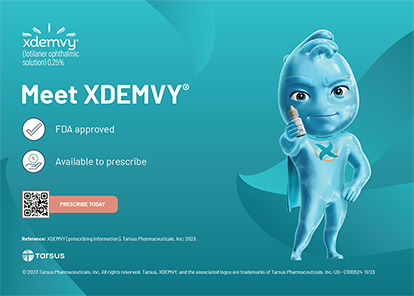
Eyelid and periocular rejuvenation is arguably the most complex and unforgiving subset of an aesthetic practice. The role of the subspecialist oculoplastic surgeon has become more prominent in this area, as aesthetic techniques have evolved and expanded. As a general rule, current techniques have shifted away from aggressive tissue removal and tightening toward volume distribution, facial contour, and balance.
My oculoplastic practice is devoted to rejuvenation of the eyelid and periocular complex. This article describes the trends in current practice and focuses on surgical blepharoplasty. In addition, I will describe some of the newer and evolving surgical and nonsurgical adjunctive procedures that I use.
BLEPHAROPLASTY
Upper Eyelid Blepharoplasty
Upper eyelid blepharoplasty (Figure 1) is often the most familiar periocular procedure to both aesthetic surgeons and ophthalmologists. It has traditionally been an excisional surgery, with the technique geared toward removing as much tissue (skin, muscle, fat) as can safely be excised.

Figure 1. Before (A) and after (B) upper eyelid blepharoplasty with lateral crease formation.
Contemporary upper lid blepharoplasty is a more balanced procedure. In my practice, skin excision is performed conservatively. Orbital fat and orbicularis muscle are only rarely excised. In addition, there is a focus on the height and shape of the eyelid crease. I routinely set both the height and contour of the crease by using crease and internal brow fixation techniques. This allows the crease to form at a natural height with a consistent shape across the lid that parallels the lid margin. In addition, I often employ periocular adjunctive procedures (described later). These include brow lifting, periocular botulinum toxin (Botox; Allergan), and volume replacement.
Lower Eyelid Blepharoplasty
Lower eyelid blepharoplasty technique recently shifted away from the traditional approach to lower eyelid fat prolapse and skin excess (Figure 2). Classically, surgery was performed through a transcutaneous approach with an incision placed below the lash line. The procedure involved dissection through both the orbicularis muscle and orbital septum to access the orbital fat. The fat and skin were then both aggressively excised. In 1989, Baylis et al1 described a transconjunctival approach to the lower eyelid that has since gained in popularity. In addition, a focus on volume restoration and balance has caused a shift away from aggressive tissue excision in lower eyelid surgery.

Figure 2. Before (A) and after (B) lower eyelid transconjunctival blepharoplasty with fat repositioning. Notice the improved volume of the orbital rim and upper cheek.
In my practice, I routinely use a transconjunctival approach to the orbital fat. The dissection spares both the orbital septum and orbicularis muscle, which is felt to greatly limit the potential of postoperative lid malposition and ocular surface pathology.2,3 In addition, I perform fat repositioning rather than excision in the vast majority of my patients. This prevents an overly hollow appearance that can occur with fat excision. The lower eyelid fat pads are reflected and secured inferiorly over the orbital rim to shift the periocular volume from where it is excessive (lower eyelid) to where it is deficient (orbital rim or lid-cheek junction). The fat is placed and secured to improve the balance and contour from the lower eyelid as it transitions to the upper cheek.
Adjunctive procedures such as aesthetic canthoplasty, skin excision or rejuvenation, volume augmentation, and muscle plication can then be performed, with no or minimal incision and dissection, to further improve the surgical result.
ADJUNCTIVE PROCEDURES
Brow Lift
The brow has an intimate relationship to the contour and appearance of the periocular complex and specifically the upper eyelid. Brow descent is very commonly observed with facial aging. If present, it is imperative that brow ptosis be addressed at the time of blepharoplasty, or the results will be limited and often unsatisfactory. Multiple brow lifting techniques have been described (Figure 3).4 I have adopted minimally invasive brow lifting techniques to achieve subtle, natural, and balanced results. This includes both lateral subcutaneous brow lifting and endoscopic brow or forehead lifting. The goal of any brow lifting procedure is to return the superficial and/or deep brow tissues to their normal anatomic position and relationship to the upper lid. Often, a relatively small elevation is needed to achieve this goal without creating an “unnatural” or “surprised” appearance.

Figure 3. Before (A) and after (B) endoscopic brow lift, upper eyelid blepharoplasty, and ptosis repair.
Skin Treatment
Skin excision during blepharoplasty can address skin excess, but often, it is skin quality and not excess that presents the majority of the aesthetic issue. Eyelid skin quality can be treated at the time of blepharoplasty by means of various treatments. Examples include a medium-depth chemical peel and laser resurfacing.
Volume Augmentation
As previously mentioned, volume has become a primary concern of contemporary periocular and eyelid aesthetic surgery. With modern blepharoplasty techniques, volume can be preserved and/or moved. Many of my patients, however, require additional volume for a complete periocular rejuvenation (Figure 4). In my practice, volume augmentation is achieved with both synthetic fillers such as injectable hyaluronic acid gel (Juvederm; [Allergan] and Restylane [Galderma]) and autologous facial fat grafting. Volume augmentation is an excellent adjunct to blepharoplasty and can address specific periocular areas such as the upper lid sulcus, the lower lid-cheek junction, the brows, the midface, and the temples. Restoration of the natural volume and contours of these areas complements the surgical results from blepharoplasty and returns balance to the entire periocular complex. In addition, injectable filler is an excellent option for the patient who desires nonsurgical rejuvenation or the patient who has had a prior surgery and is hollow in the eyelid or periocular area from the overexcision of soft tissue.

Figure 4. Before (A) and after (B) lower eyelid treatment with injectable hyaluronic acid gel filler.
Conclusion
Eyelid and periocular rejuvenation continue to be complex and challenging. As techniques and technologies develop and evolve, aesthetic outcomes will only become more rewarding for both patients and surgeons.
1. B aylis HI, Long JA, Groth MJ. Transconjunctival lower lid blepharoplasty. Technique and complications. Ophthalmology. 1989; 96(7):1027-1032.
2. Neuhaus R, Baylis H. Complications of lower eyelid blepharoplasty. In: Putterman AM, ed. Cosmetic Oculoplastic Surgery. New York, NY: GrundStratton; 1982:429-456.
3. McGraw BL, Adamson PA. Postblepharoplasty ectropion. Arch Otolaryngol Head Neck Surg. 1991;117:852-856.
4. Paul MD. The evolution of the brow lift in aesthetic plastic surgery. Plast Reconstr Surg. 2001;108(5):1409-1424.
Jeffrey M. Joseph, MD
• ophthalmic plastic and reconstructive surgeon, Newport Beach, California
• (949) 424-3524; http://ococuloplastic.com


